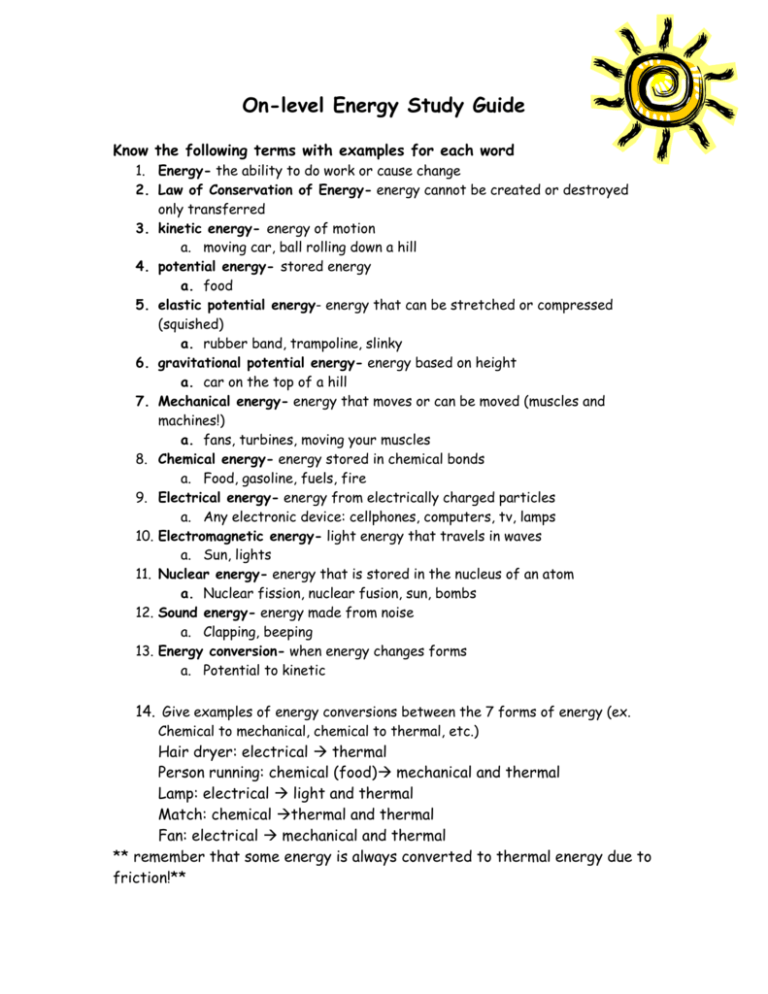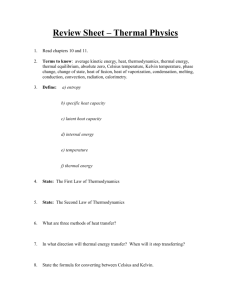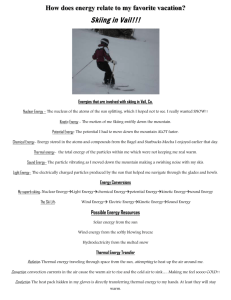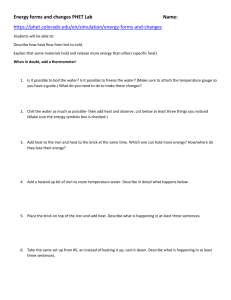Energy and Thermal Energy study guide onlevel
advertisement

On-level Energy Study Guide Know the following terms with examples for each word 1. Energy- the ability to do work or cause change 2. Law of Conservation of Energy- energy cannot be created or destroyed only transferred 3. kinetic energy- energy of motion a. moving car, ball rolling down a hill 4. potential energy- stored energy a. food 5. elastic potential energy- energy that can be stretched or compressed (squished) a. rubber band, trampoline, slinky 6. gravitational potential energy- energy based on height a. car on the top of a hill 7. Mechanical energy- energy that moves or can be moved (muscles and machines!) a. fans, turbines, moving your muscles 8. Chemical energy- energy stored in chemical bonds a. Food, gasoline, fuels, fire 9. Electrical energy- energy from electrically charged particles a. Any electronic device: cellphones, computers, tv, lamps 10. Electromagnetic energy- light energy that travels in waves a. Sun, lights 11. Nuclear energy- energy that is stored in the nucleus of an atom a. Nuclear fission, nuclear fusion, sun, bombs 12. Sound energy- energy made from noise a. Clapping, beeping 13. Energy conversion- when energy changes forms a. Potential to kinetic 14. Give examples of energy conversions between the 7 forms of energy (ex. Chemical to mechanical, chemical to thermal, etc.) Hair dryer: electrical thermal Person running: chemical (food) mechanical and thermal Lamp: electrical light and thermal Match: chemical thermal and thermal Fan: electrical mechanical and thermal ** remember that some energy is always converted to thermal energy due to friction!** 2. T M 1. 4. a 3. EM NT ME 4. b MT 15. Describe one specific energy conversion that occurs in a nuclear generator. Steps 12: nuclear energy converted to mechanical energy; nuclear reactions create steam to turn turbines Steps 23: Thermal energy converted to electrical energy; steam turns turbines to generate electricity Steps 34a: Mechanical energy converted to mechanical energy; the turning turbine delivers electricity to homes Steps 34b: Mechanical energy converted to thermal energy; the turning turbine is cooled off by thermal energy 16. Compare/contrast KE and PE a. Know what 2 things kinetic energy depends upon a. Mass: the larger the mass the greater the KE b. Velocity: the faster the object the greater the KE b. Know the 2 types of potential energy a. Gravitational potential energy b. Elastic potential energy c. Know the 2 things gravitational potential energy depends upon a. Height- the higher the object, the greater the PE b. Weight- heavier the object, the greater the PE 17. Describe the law of conservation of energy as it applies to a pendulum; a. where would you find the maximum PE? 1. At the highest points (1 and 5) b. maximum KE? 1. At the lowest point (3) c. where are PE/KE conversions occurring? 1. Between the highest to lowest points (2 and 4) Know the following terms with examples for each word 18. Temperature- the AVERAGE kinetic energy in an object a. 100 degrees Celsius 19. Heat- the movement of thermal energy from one object to another a. Sun, light bulbs 20. Thermal energy- the TOTAL kinetic energy in an object a. Sun, toaster ovens 21. absolute zero 22. conduction- heat transfer through direct contact (touching) a. pot on the stove, feet on hot ground 23. convection- heat transfer via the up and down movement of liquids and gases a. ocean currents, air currents, hot air rising 24. radiation- heat transfer from electromagnetic waves (light) a. sun, fire, light bulbs 25. insulator- slows energy transfer (keeps heat in) a. winter hat, sweatshirts, gloves, Styrofoam 26. conductor- allows heat transfer to flow freely and easily a. metals Describe the following concepts: 27. Explain the difference between temperature, heat, and thermal energy a. Temperature is the AVERAGE kinetic energy whereas thermal energy is the TOTAL kinetic energy and heat is just the movement of thermal energy 28. Explain the 2 things thermal energy depends on? a. Temperature- (same size) the hotter something is the more thermal energy b. Size of the sample- (same temperature) the larger the sample, the more thermal energy 29. Explain what happens to matter at absolute zero 30. Describe and give examples of the 3 ways thermal energy is transferred a. conduction- heat transfer through direct contact (touching) a. pot on the stove, feet on hot ground b. convection- heat transfer via the up and down movement of liquids and gases a. ocean currents, air currents, hot air rising c. radiation- heat transfer from electromagnetic waves (light) a. sun, fire, light bulbs 31. Know the difference between an insulator and a conductor and give examples of each. a. Conductors allow heat to transfer easily and insulators do not allow heat to transfer easily. b. Conductors: metal c. Insulators: Styrofoam, mittens, winter hats 32. Which direction does heat always transfers or flow? a. High thermal energy (hot) to low thermal energy (cold) ***Remember the test will also include CRCT Questions*** -Review the difference between elements and compounds -Know the distance-force trade off for how machines work -Know the difference between speed and velocity -know what happens to gravity as distance changes - Know how to reduce and increase friction - Know how fixed pulleys work -Know what flammability is








